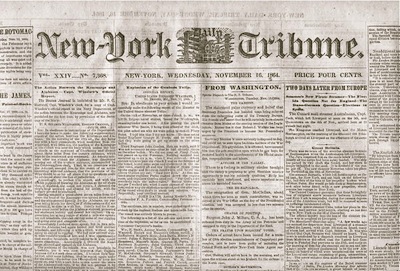The Future of Newspapers? Watch the Nineteenth Century

November 16, 1864 edition of the New York Tribune. Credit: Wikipedia
Opinionated millionaires purchase newspapers to champion their political views and ideas about urban growth and economic renewal. The same stories appear in morning papers around the country, the result of ever-more reliance on wire services. New production processes allow vivid images to practically jump off the page, and the variety of topics covered increase. Some newspapers appear daily, but others seek out niches that work best for their readers and advertisers, whether publishing morning and evening, once a week, or -- perhaps most interestingly -- in a tri-weekly format.
Welcome to the twenty-first century in the newspaper business. Or, rather, welcome back to the nineteenth.
In recent weeks, media stories have focused on the use of the San Diego Union-Tribune by local real-estate developer Doug Manchester, while covering the latest revelations in the scandals surrounding Rupert Murdoch’s newspapers.
Wire-service stories -- from the New York Times and Washington Post, as well as the Associated Press and Reuters -- appear in newspapers around the country, as other newspapers stop staffing national and international bureaus.
The Internet has been a disruptive competitor for print formats, but journalism itself is flourishing -- in the hands of enthusiastic near-amateurs on sites like Patch.com; in the innovative use of new formats and around-the-clock production by organizations as diverse as the Drudge Report and Pro Publica; and by creating an interface between readers and reporters through instant online comments, Twitter accounts, and Facebook reader plug-ins. Meanwhile, the New Orleans Times-Picayune is the latest print newspaper to reduce themselves to three days in an effort to balance the books.
These are certainly dramatic changes, but they are not brand-new innovations. In many cases, they mark a return to nineteenth-century models.
Before objectivity was the goal of the most respected journalists, the newspaper trade was ruled by the political parties. The party organs championed their candidates and ridiculed the opposition -- a segmented approach to media consumption and political news that has surely returned as well.
Technical innovations such as the steam press and chromolithography made newspaper printing cheaper, illustrations easier and more vivid -- much as the podcasts, photo galleries, and clicks on a QR code make possible today.
Once the transatlantic cable was laid, the era’s most important technology, the telegraph, made instant around-the-world coverage of news events possible, and led to the creation of the Associated Press and other wire services. Extras could be printed when news arrived, whether daily, weekly, tri-weekly, or by the hour.
Conversations in coffeehouses, pubs, and public transportation processed what the news meant. The same occurs in these same locales today, though at the time it was a debate held out loud, rather than by tapping on a screen.
In our day, media personalities rise on the quality of their tweets or their websites. Similarly, the broadening of print journalism in the nineteenth century led to the creation of such stars as Charles Dickens and Mark Twain, cartoonist Thomas Nast and editor Horace Greeley, who used the platform of fame from his newspaper to run unsuccessfully for president in 1872.
Media writers have bemoaned the seeming demise of newspapers in print form, while occasionally remembering to champion those websites -- linked to traditional media outlets or not -- that have found innovative, interactive, and, yes, sometimes even profitable ways of sharing the latest news, championing the cause, providing the update from the front yard or from the farthest reaches of the planet.
As media consumers and producers seek new ways to reinvigorate journalism today, it is worth keeping in mind that many of their innovations repeat nineteenth-century choices. The business then saw a similarly radical transformation and sprouted new forms in response -- some successful, some short-lived.
Perhaps this historical knowledge can change our perspective. Rather than sit on death watch for print newspapers, we see can today’s media environment as the productive chaos that will offer up the next comedic genius, the next form of investigative journalism, and -- who knows -- a media mogul who could run for president.
